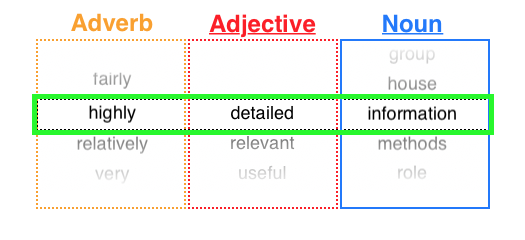Collocation and Noun Modification
Different words have different collocations
You already know that adjectives are used to describe nouns (delicious ice-cream), and perhaps that nouns can be used like adjectives (strawberry ice-cream). But adjectives, nouns and adverbs can all be used in various combinations to build complex noun phrases, in this case premodification A word or phrase which gives further information about another word or phrase and placed before the head. more... Go to the Noun Premodification page. The head The head (or headword) is the main word in a phrase. Other parts of a phrase have a modifying or grammatical relationship with the headword. more... noun "ice-cream" is premodified by the adjective "delicious" in the first example and by the noun "strawberry" in the second.
You can see if you scroll through the list of nouns below that the adjectives change. The most common adjective collocates for each noun are placed at the top and, as you scroll through the adjectives for that noun, the likeliest adverbs for each adjective appear. For example for the noun "time" the commonest adjective collocates are "long", "short", "good", "considerable", "hard", "valuable", …. . And for each adjective-noun combination the list of possible adverbs changes.
If you are a fluent speaker and writer of English, this may seem rather obvious. But if you are not, it is worthwhile taking some time to notice which are the commonest collocates for particular words and phrases. In this way your writing will improve.
1. Change the head noun to find suitable adjective collocates and change the adjective to find suitable adverb collocates for each adjective-noun phrase
2. Change the participle to find possible head noun collocates and adverb collocates for each participle-noun phrase
Verb participles (verb+ing or verb+ed) often function as adjectives. As such they can be modified with adverbs.
3. Change the head noun to find possible colour collocates and the colour to find suitable adjective collocates for each colour-noun phrase
Nouns are sometimes modified by colour adjectives, which in turn can be modified by other adjectives. However, each adjective may separately modify the noun. For example, "long" in "long red hair" modifies "hair", not "red".
4. Change the head noun to find possible participle collocates and change the participle to find possible adjective collocates for each participle-noun phrase
Nouns can also be modified by ing-participles or ed-participles and adjectives, as we saw above. This example shows ing-participles. They modify nouns. So they look like adjectives but in fact they are often acting as nouns as in the Adjective Noun Noun pattern below. In this pattern the adjective is normally modifying the whole of the participle-noun phrase: e.g. strategic [planning system].
5. Change the head noun to find possible noun modifier collocates and change the noun modifier to find possible adjective collocates for each noun-noun phrase
In this pattern the head noun is modified by another noun and the noun-noun phrase is modified by an adjective. For example, favourite [television programme]. A noun-noun phrase can also be modified by a further noun. There are a few examples in the above table. For example, database [management system].
You can see much more about noun phrases on the Noun Phrases section of the site.
Notes
Only the words which appear in the central horizontal strip can be considered acceptable collocates. Underlined headings indicate categories whose collocates change when scrolling occurs.

